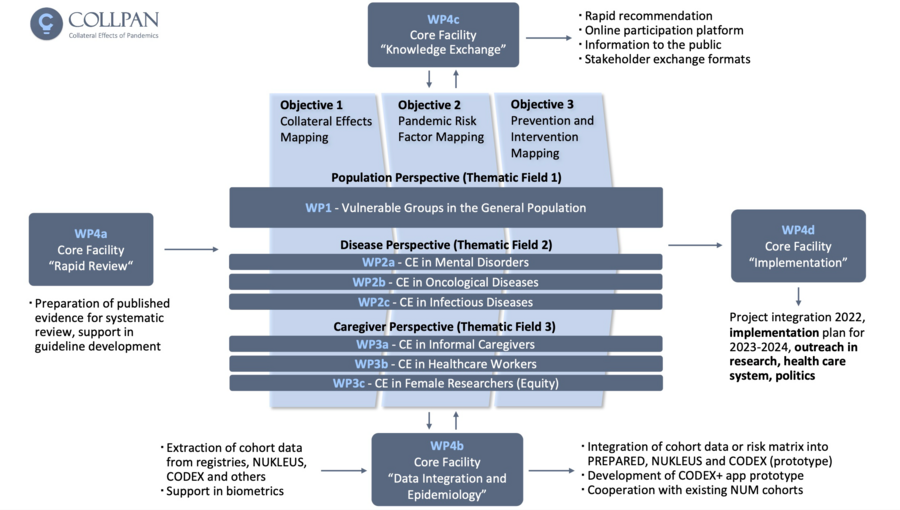About the project
In CollPan, a nationwide platform is being set up to establish evidence-based and sustainable research on collateral effects of the current pandemic and for future pandemics and crises. To this end, a structured mapping of collateral effects, risk factors and existing interventions and therapies against collateral effects is being carried out (see figure). These three approaches are addressed in three subject areas: in the general population (subject area 1), in selected patient groups particularly affected by collateral effects (subject area 2) and in employees in health and scientific institutions (subject area 3).
To achieve these project objectives, existing data from registries and routine data platforms will be used and new data will be collected. The results will be processed in systematic reviews and for guidelines and the data collected will be integrated into the NUM infrastructures. The results and recommendations are also to be addressed to the public transparently and quickly.
CollPan researches the collateral health effects of pandemics and their factors in order to enable surveillance of collateral effects. The establishment of a surveillance infrastructure is intended to protect society in general and vulnerable groups in particular. Collateral effects in children and adolescents are recorded in close collaboration with the Napkon, coverCHILD and PREPARED projects.
CollPan focuses on three main objectives: (1) mapping collateral effects, (2) mapping factors influencing vulnerability and resilience, and (3) mapping available measures to mitigate collateral effects. This will enable a rapid response to future health crises or pandemics at national level as a preparedness structure. CollPan 's structures in terms ofgovernance and core units support a close connection and interaction with all relevant NUM structures and projects, e.g. rapid evidence synthesis/recommendation with PREPARED, cohort visualisation and data integration with CODEX or NUKLEUS ECU, use cases for mobile interventions with CODEX+ and knowledge sharing with coverCHILD, among others.
CollPan will support joint data integration, exchange, analysis and publication with all other NUM projects. The evidence-based knowledge collected in seven work packages on collateral effects of current and future pandemic crises, evidence gaps and evidence-based prevention and intervention strategies will be integrated into an implementation plan. This will form the conceptual framework for the development of an evidence-based, collaborative and customised surveillance infrastructure. This structure will enable rapid identification of vulnerability or resilience to collateral effects, set "red flags", inform decision-makers and provide targeted interventions to ensure the health of the population by protecting against negative collateral effects.
The central parts of CollPan consist of seven work packages (WP) in three subject areas in which collateral effects are analysed in relevant populations:
- in the general population (e.g. age-related susceptibility, collateral effects in children and adolescents in collaboration with coverCHILD), WP1
- within relevant vulnerable groups with pre-existing conditions: mental illness, cancer and infectious diseases, AP2a-c, and
- within relevant vulnerable groups. Specific examples examined here are family carers, employees of the healthcare system and mothers working in science, WP3a-c
All seven work packages systematically pursue three main objectives :
- Systematisation of the immediate and delayed, harmful and beneficial collateral effects of the pandemic on health (Objective 1: Typology of collateral effects)
- Systematisation of general and population-specific factors that influence susceptibility and resilience to collateral effects before, during and after the pandemic (Objective 2: Risk factor mapping)
- Systematic collection and evaluation of currently available or implemented interventions to prevent negative collateral effects and/or to provide therapeutic measures to treat collateral effects that have already occurred (Objective 3: Intervention mapping)
By pursuing these objectives, CollPan also plans to identify and characterise evidence gaps and missed opportunities with regard to the identification of collateral effects and the development of protective measures. In order to achieve these goals, it is necessary to use existing data from registers and routine data platforms as well as to collect new data that has not yet been collected in this way. This applies in particular to the work packages that deal with the implemented interventions to prevent collateral effects and work qualitatively. To date, there is no existing data to fall back on - this applies, for example, to the area of serious mental illness and unequal career opportunities.
The results are to be processed in systematic reviews and for guidelines and the data collected is to be integrated into the NUM infrastructures. The results and recommendations should also be reported transparently and quickly to the public.
A Steering Committee was established with the following people and organisations:
- Prof. Dr Simone Kühn, Head of AP1, UMC Hamburg
- Prof Dr Till Bärnighausen, Head of AP1, UMC Heidelberg
- Prof Dr Martin Lambert, Head of AP2a, UMC Hamburg
- Prof Dr Christina Andreou, PI AP1, UMC Schleswig-Holstein
- Prof Dr Sebastian Paris, Head of WP 3b, UMC Berlin
- Prof Dr Alexander Mellmann, Head of AP2c, UMC Münster
- Prof Dr Lukas Radbruch, Head of AP3a, UMC Bonn
- Prof Dr Rudolf Hagen, Head of AP2b, UMC Würzburg
- Prof Dr Georg Häcker, Head of AP2c, UMC Freiburg
- Representative of coverCHILD
- Representative of the patients





